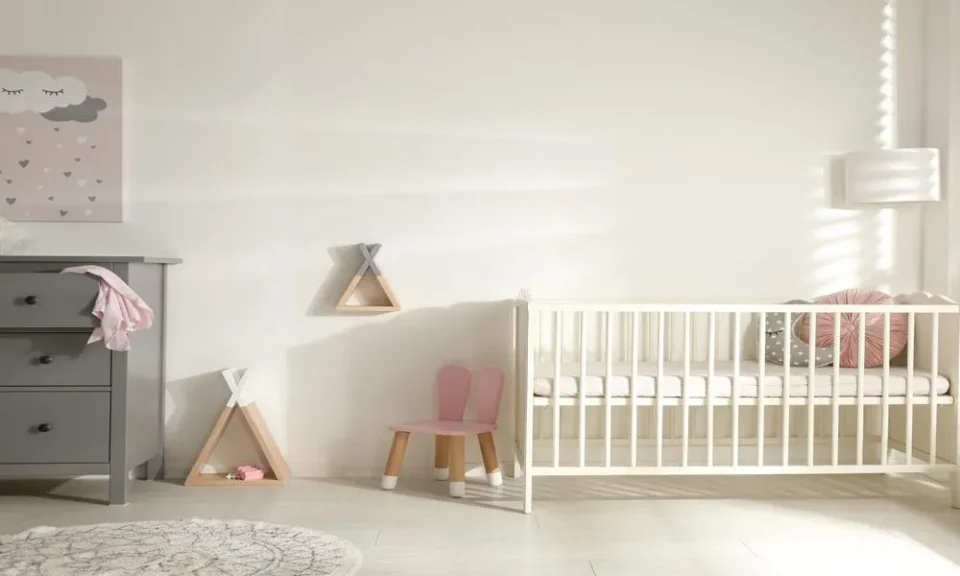Selecting the right crib size requires carefully considering your nursery dimensions, layout, and future plans. A comprehensive mini crib vs standard crib guide helps you evaluate which option maximises your available space while meeting your baby’s needs. This critical nursery decision impacts aesthetics, functionality, and longevity of your baby’s primary sleep space.
Space requirements
When assessing your nursery dimensions, consider that standard cribs occupy approximately 28″ × 52″ of floor space, while mini cribs require only 24″ × 38″. This 14-inch length difference creates dramatically different footprints in your nursery layout.
In smaller nurseries under 100 square feet, a mini crib preserves valuable floor space for other essentials like a changing table, dresser, or glider. The saved square footage—nearly 5 square feet compared to standard cribs—can mean the difference between a crowded room and one with comfortable walking paths. Parents with nurseries in converted closets, alcoves, or shared bedrooms often find mini cribs as the only practical option, allowing proper furniture arrangement.
Standard cribs make more sense in at least 120 square feet nurseries, where their larger footprint won’t dominate the floor plan. Their considerable size is an anchor piece in more spacious rooms, creating a natural focal point around which other furniture can be arranged. If your nursery has ample dimensions, the standard crib’s presence helps balance larger rooms without making the space feel empty or poorly planned.
Room layout
Your nursery’s specific shape and configuration may strongly favour one crib type:
- Corner placements often accommodate mini cribs without blocking windows
- Rooms with multiple doors or pass-through areas maximise traffic flow with mini cribs
- Long, narrow rooms may require mini cribs to maintain proper clearance paths
- Square rooms with central placement opportunities benefit from standard cribs
- Rooms with architectural features (bay windows, built-ins) often work better with adjustable mini crib positioning
Mini cribs excel in awkward spatial challenges, fitting into nooks and corners where standard cribs protrude into walkways. Their smaller size allows placement under windows without blocking natural light—a critical consideration for maintaining a cheerful nursery atmosphere and practical diaper changes.
Standard cribs work best when centred on walls or as room dividers in open-concept spaces. Their substantial presence helps define areas in larger nurseries or combined nursery/playroom layouts. They create natural circulation patterns around the room’s perimeter when placed centrally, enabling easy access from multiple sides.
Small space design
Limited nursery dimensions call for creative solutions to maximise functionality:
- Wall-mounted shelving above mini cribs utilises vertical space without a floor footprint
- Under-crib storage works better with standard cribs’ higher clearance
- Slim dressers paired with changing pads work alongside mini cribs in tight spaces
- Corner changing tables complement mini cribs in square-footage-challenged nurseries
- Door-mounted organisers offset storage limitations in mini-crib nurseries
In apartments and urban homes, mini cribs and multifunctional furniture create complete nurseries in spaces as small as 6 × 8. This compact approach often places the mini crib against the shortest wall, preserving the longer wall for storage solutions. The space saved can accommodate a small nursing chair or glider—an arrangement impossible with standard cribs in similarly sized rooms.
Homes with dedicated but modest nurseries often benefit from standard cribs when their dimensions allow. The additional sleep space remains useful longer, adapting as your baby grows into a more active sleeper who uses the entire mattress area. A standard crib leaves sufficient clearance for other essentials in rooms measuring at least 10 × 10 without creating a cramped environment.
Standard cribs may provide better long-term value for growing families with planned siblings despite their larger footprint, especially if nursery space isn’t severely constrained. Their durability and longer useful lifespan often outweigh the space premium they command, serving multiple children across several years.

